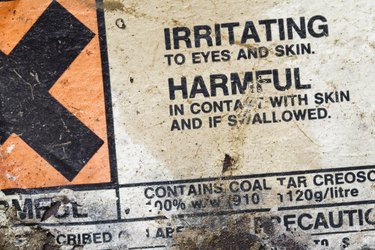
Creosote is a mixture of several chemicals that are used as pesticides and wood preservatives. It's often used on railroad ties and utility poles to protect the wood. While it's effective for those uses, creosote is also a toxic substance that can be very dangerous. Inhaling the fumes or smoke from burned creosote-treated items, drinking from a groundwater supply contaminated by creosote, or ingesting or making skin contact with the chemicals can cause creosote poisoning. This can result in a variety of health issues. Knowing creosote exposure symptoms can help you identify this condition if you have been exposed to it.
Difficulty With Breathing
Video of the Day
When creosote is inhaled or ingested it can lead to breathing issues. Difficulty breathing or the inability to breathe deeply may result from overexposure to the toxin. Shortness of breath is likely to occur as well. This might happen if you burn wood treated with creosote or if you're in the area when someone else is burning it. For this reason, it's recommended never to burn old railroad ties if you have them in your landscaping.
Video of the Day
Disorientation or Dizziness
A lightheaded feeling may be associated with exposure to creosote. This dizziness might make you feel like you're going to pass out. You might also experience with dizziness along with nausea or disorientation. This happens because the chemicals disrupt the level of oxygen to the brain or in the blood.
Myoclonus Creosote Exposure Symptoms
Creosote poisoning can cause a symptom called myoclonus. A myoclonus is an involuntary jerk of a muscle. These sudden muscle contractions are common in the form of a hiccup, but with creosote toxicity in humans, there could be a wide range of muscles affected by myoclonus.
Nose, Skin and Eye Irritation
Irritation to the eyes, lining of the nose and the skin is likely if you're exposed to creosote. The effects of creosote exposure may be similar to a severe allergic reaction. Other skin reactions include discoloration and sensitivity to sunlight. It can also cause nosebleeds, dilated pupils and partial loss or blurring of your vision. Creosote is a carcinogen and could result in nasal or sinus cancer.
Vital Organ Damage
Some vital organs may be damaged as a result of poisoning by creosote. Lung damage can be caused by inhaling creosote and may potentially lead to lung cancer. Creosote can also cause liver damage and kidney damage sometimes apparent because of dehydration and lack of urination. Poisoning may also cause irregular heartbeats.
How to Avoid Problems
Creosote is not approved for residential use, but you still may come into contact with potentially poisonous creosote through discarded railroad ties, utility poles or other treated wood. Your risk of contracting problems increases with cutting and burning of creosote-treated wood products. If you have to handle such products, be sure to wear long sleeves, pesticide-resistant gloves, protective eyewear, a respirator and coveralls.
And just as important as taking protective precautions is knowing the symptoms that may be experienced when you, or those around you, touch, inhale or ingest creosote. This enables you to get treatment quickly before severe health issues develop.